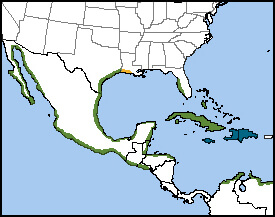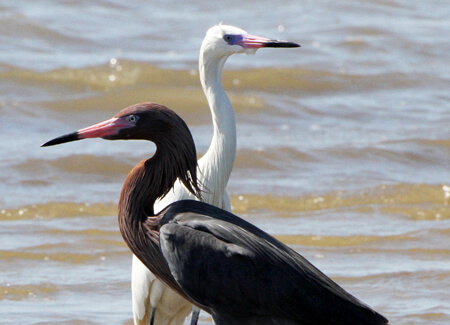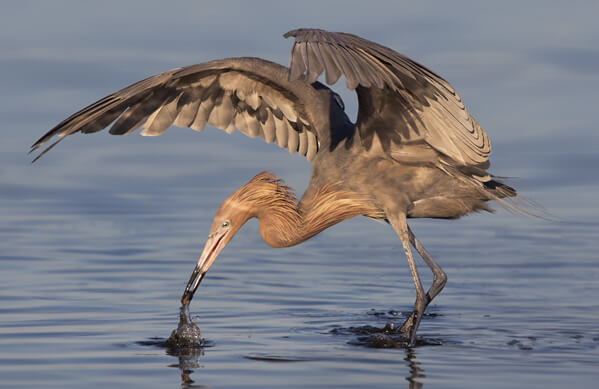 The Reddish Egret is one of the rarest egrets in North America. It's easily distinguished from other egrets and herons by its shaggy appearance, hyperactive feeding behavior, and pink-and-black bill.
The Reddish Egret is one of the rarest egrets in North America. It's easily distinguished from other egrets and herons by its shaggy appearance, hyperactive feeding behavior, and pink-and-black bill.
Reddish Egret numbers in the U.S. were decimated by plume hunters in the 19th century, and populations never fully recovered. Like Snowy and Wilson's Plovers, this species is dependent on coastal habitats for successful foraging and breeding—the same areas that are vulnerable to sea level rise caused by climate change. Habitat loss is another problem for this bird.
The species occurs in two color morphs: a dark morph characterized by a slate-blue body and reddish head and neck, and a white morph that features completely white body plumage. The two-toned bill and shaggy neck are distinctive in both plumages.
Running Down Dinner
The Reddish Egret stalks its prey—mostly small fish—more actively than other herons and egrets. The birds first locate their quarry by sight, then the dance begins. They dash, lurch, and zig-zag after their prey, often holding their wings over the water as they hunt. This shadow-casting strategy is thought to reduce glare and help the egret more accurately sight and spear its prey.
It's a social species except when feeding, when they aggressively defend feeding territories from a variety of other birds.
Sign up for ABC's eNews to learn how you can help protect birds

Reddish Egret by Larry Thompson
Nesting in Numbers
Like the Wood Stork, the Reddish Egret is a colonial species that can be found nesting alongside other egrets, herons, cormorants, and spoonbills. The birds favor coastal islands with mangroves, low bushes, or even prickly pear cacti, which may provide some protection from predators. They will also use man-made nesting spots such as dredge islands.
Both the male and female build a platform nest of sticks, continuing to add material to the nest as the female incubates. Reddish Egrets do not breed until their third or fourth year. Their courtship behavior is variable and entertaining to watch; some of the notable behaviors include head tossing; raising the neck, back and crest feathers; bill clacking; and loud calling followed by chases and circle flights.
The season of nesting seems to be flexible across this bird's range.
Working for Reddish Egret
The Reddish Egret benefits from many of the conservation efforts ABC has put in place for beach-nesting birds, particularly through our Texas campaign, “Fish, Swim, and Play from 50 yards away…” (from birds nesting on islands and beaches). We ask boaters and anglers to give birds the space they need to safely raise their young without disturbance or interference from people.
In addition, many of ABC's conservation projects protect carbon-rich tropical forests—our contribution to slowing climate change and accompanying sea-level rise. By creating more than 70 bird reserves, we have protected nearly one million acres of forest.
Donate to support ABC's conservation mission!



















































